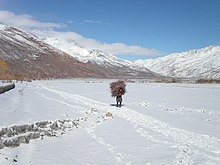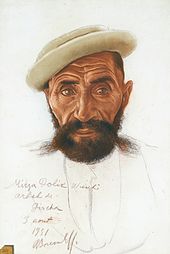Wakhi
The Wakhi or Khik (also Guhjali in upper Hunza, Pakistan ) are an ethnic group in the Wakhan in the Badachshan region in northeastern Afghanistan . They also live in neighboring areas of Tajikistan , in Xinjiang and Pakistan, in both the Chitral district and Gojal. They speak the Southeast Iranian Wakhi language. The name Wakhi is derived from the English form of the Wakhan Corridor, a passage from the Pamir Mountains to the Tarim Basin, through which the Silk Road also runs. Researchers see the language therefore possibly more closely related to the extinct ancient Sakish .
Population and demographics

A very rough estimate is 70,000 to 100,000 members of the Wakhi ethnic group. The population is spread over four countries: Afghanistan , Tajikistan , Pakistan and China . In the Chinese Autonomous Region of Xinjiang , the Wakhi are officially recognized as " Tajiks " and in Afghanistan they are officially recognized as "Pamiris". In Tajikistan, the Wakhi are recognized by the state as Tajiks, although they refer to themselves as Pamiris. In Pakistan they call themselves "Pamiris" and Guhjali. As far as religious affiliation is concerned, the Wakhi mostly belong to the Nizarites , an Ismaili group of Shiite Islam , the head of which is the Aga Khan .
economy
The Wakhi are primarily nomads who roam around with their herds of yaks and horses. They often have two branches, one for summer and one for winter. Their houses are made of stones and sod .
Wakhi Cultural Association
In Pakistan there is an association of the Wakhi, the Wakhi Tajik Culture Association Pakistan (WCA). The organization works with the Pakistani Ministry of Culture and Tourism and the Lok Virsa Folklore Museum in Islamabad . The WCA aims to preserve the language and culture of the Wakhi and to record their poetry and music . The WCA has hosted more than 20 programs since 1984, including cultural shows, musical evenings, and music festivals, in partnership with Lok Virsa Pakistan, Aga Khan Cultural Service Pakistan (AKCSP), and Pakistan Television .
media
The radio station of Radio Pakistan in Gilgit broadcasts the Wakhi radio program "Sadoyah Boom-e Dunyo" (Voice of the Roof of the World). A computerized codification of the Wakhi script has been published. This should enable researchers to record and document the poetry, literature and history of the Wakhi.
literature
- Sabine Felmy: The Voice of the Nightingale: A Personal Account of the Wakhi Culture in Hunza. Oxford University Press, New York 1996, ISBN 0-19-577599-6 .
- M. Nazif Mohib Shahrani: The Kirghiz and Wakhi of Afghanistan: Adaptation to Closed Frontiers and War. University of Washington Press, Seattle 1979, ISBN 0-295-95669-0 ; 1. Paperback edition with new foreword and epilogue 2002, ISBN 0-295-98262-4 .
Web links
- The Wakhi in Afghanistan. The hidden people on bluewin.ch
- History on wakhi.wordpress.com (English)
Notes and individual references
- ^ Distribution of Wakhi Ethnic Group. Gojal.net, archived from the original on October 7, 2011 ; accessed on November 24, 2016 .
- ^ David J. Phillips: Peoples on the Move: Introducing the nomads of the world Piquant, Carlisle 2001, ISBN 1-903689-05-8 , p. 271 ( books.google.com Restricted Preview).
- ↑ Kenneth Coates: A global history of indigenous peoples. Struggle and survival . Palgrave Macmillan, New York 2004, ISBN 1-4039-3929-2 .
- ^ A b Barbara A. West: Encyclopedia of the peoples of Asia and Oceania . Facts On File, New York 2009, ISBN 978-0-8160-7109-8 .
- ↑ M. Nazif Mohib Shahrani: The Kirghiz and Wakhi of Afghanistan. University of Washington Press, Seattle 2002, p. 216, ISBN 0-295-98262-4 ( books.google.com ).
- ↑ a b Khyber Pakhtunkhwa: People and Tribes . Government of the Khyber Pakhtunkhwa. Archived from the original on March 16, 2015.
